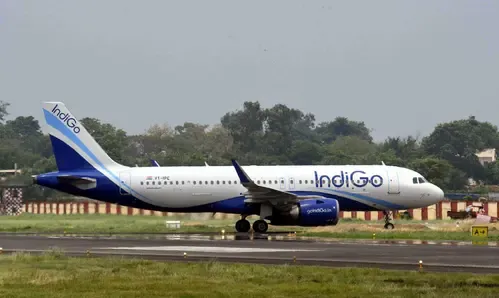Did an IndiGo flight with 140 passengers on board make an emergency landing in Indore?

Synopsis
Key Takeaways
- IndiGo Airlines faced two emergency landings within a short period.
- Flight 6E 813 made an emergency landing in Indore due to a hydraulic malfunction.
- All passengers and crew members were reported safe.
- Regulatory authorities are expected to review maintenance protocols.
- Passengers expressed gratitude for the crew's effective management of the situations.
Indore, July 21 (NationPress) - IndiGo Airlines encountered a series of technical issues this week, raising significant concerns regarding the operational integrity of its Airbus A321neo fleet. Flight 6E 813, which was traveling from Goa to Indore, was compelled to execute an emergency landing on Monday due to a suspected hydraulic failure in its wheel system, which activated an undercarriage warning while in flight.
The aircraft took off from Goa’s Dabolim Airport at 3:14 p.m. and was nearing Indore when the pilot notified Air Traffic Control about the abnormal hydraulic behavior related to the landing gear. As a safety measure, the plane circled the airspace above Indore seven to eight times while emergency response teams were deployed on the ground.
Fire brigades, medical personnel, and airport staff were stationed along the runway in anticipation of a potentially dangerous landing. The aircraft successfully landed at 5:08 p.m., with all 140 passengers and crew members reported safe. This incident marks the second similar alert for the airline within a span of 24 hours.
The day prior, flight 6E 6591 from Tirupati to Hyderabad faced its own technical difficulties shortly after takeoff. Flight tracking data from FlightRadar24 indicates that the flight departed from Tirupati Airport at 7:42 p.m. but was forced to circle overhead before returning to land at 8:34 p.m. This flight, also an A321neo, was the final scheduled service from Tirupati to Hyderabad for the day and was subsequently cancelled.
IndiGo has not yet provided a detailed statement regarding either incident.
Aviation experts believe both incidents were precautionary actions triggered by cockpit alerts rather than structural failures.
Nevertheless, the occurrence of two mechanical alerts involving the same aircraft model has attracted attention from civil aviation regulators, who are anticipated to commence a review of maintenance protocols and alert response procedures.
Passengers aboard both flights have expressed gratitude for the crew’s effective management of the circumstances, while aviation analysts await formal clarifications from the airline and regulatory bodies concerning any underlying causes or trends associated with these unexpected malfunctions.










